Written by Dan Schroeder, EasyCare’s Hoof Care Practitioner & Veterinarian Dealer Representative
I have talked with many different hoof care professionals and horse owners about what to put under an EasyShoe for support, protection, or to simply keep foreign material from getting up under the shoe. My answer is always the same. I recommend using Dental Impression Material (DIM). The common response is, “What is DIM?”
In my opinion, DIM works great for multiple reasons.
It stays in place.
It adds support to the bony column.
It adds a layer of protection.
It doesn’t shrink or change density.
DIM comes in a few different densities: extra soft, soft, medium, and hard. I have used all of them, and I really haven’t seen much of a difference in most of the horses that I have tested. That being said, I typically carry either the soft or medium DIM on my truck.
How to apply DIM under an EasyShoe:
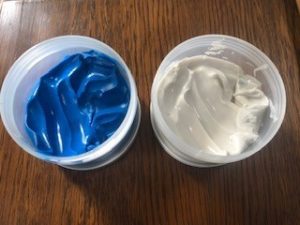
DIM is sold as a two-part product. It resembles Play-Doh.

This is Bob. He will be our model for today.
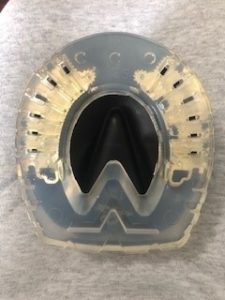
Bob will be getting an application of DIM under the EasyShoe Versa Grip Gold. He likes the flexibility the shoe provides, but he wants more support.

Scoop out an equal portion of the blue and the white DIM material. You’ll want to use enough to have some extra. Some people only use enough to fill in the concavity of the foot, but I want extra so it will also come up into the center of the shoe (photo following).
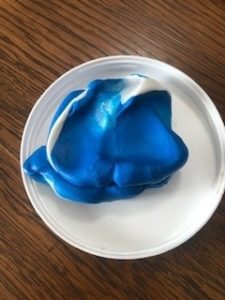
Mix the two parts together until they are completely blended as one.
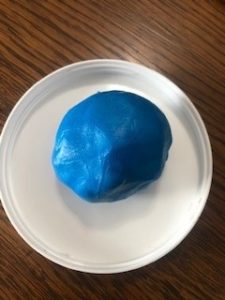
Now we have a completely blended ball of DIM to apply to the foot. Once these are blended, they will start to cure, so now you are on the clock to get the DIM applied to the foot and get the shoe in place. The curing process will take a few minutes, so don’t get in such a hurry that you make mistakes. Just like with glue, the warmer the temperature is, the faster it will cure. The colder it is, the slower it will cure.

Before DIM application, I like to apply an anti-microbial clay to the foot to help protect against moisture and any nasty fungi or other microorganisms. Next, apply the DIM to the bottom of the foot. Fill the commissures and the middle of the foot, leaving more DIM in the center of the foot, where the open center of the shoe will be, and less at the heel.

Press the shoe down onto the foot and the DIM. This will spread and flatten the DIM under the shoe, and push the excess DIM into the center of the shoe. I don’t want to fill the center of the shoe all the way. I like to see half to three quarters of the hole filled.
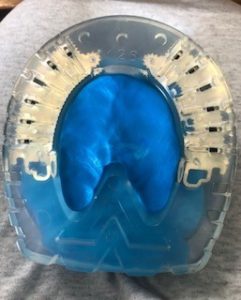

At this point, you can smooth out the DIM in the center of the shoe to make it flat, remove any excess, and also smooth out the DIM at the back of the shoe to help lend support to the heel bulbs.
Now you’re ready to nail or glue the shoe onto the foot.
If you are using the 11 Finger Tabs, you will put the foot on the ground and apply the EasyShoe Quick Set Super Glue.
PLEASE NOTE!! DIM leaves an oily residue on whatever it touches. Do NOT let this residue touch any area where you are wanting to apply glue. The oily residue will prevent your glue from achieving a secure bond, and can lead to premature bond failure. In addition, be mindful of what you touch after you have touched the DIM. Your hands will be oily.
Occasionally I am asked how the DIM can be absent when it’s time for the shoe to be reset or replaced. I have seen this happen, and I cannot explain how it gets out from under that shoe. However, in those instances where the DIM was missing, there was not as much DIM applied to the foot as what I have used in the pictures above, and in my practice. If you bring the DIM up into the center of the shoe, you should not experience any DIM loss. To illustrate this, Bob let us take a few more pictures.
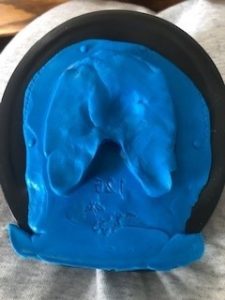
The above photo was taken after the shoe was removed so you can better see how much DIM was under the shoe and how much was coming up into the center of the shoe. You will also see an indentation of the EasyCare running horse logo.

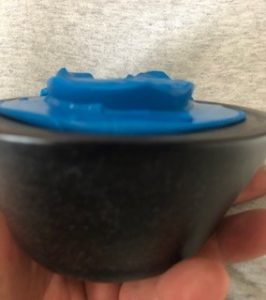
As you can see, the DIM is locked in place so it cannot fall out mid-trim cycle.
I would recommend you try using DIM in your next application. Not all horses need it, but there are plenty that benefit from the added support and protection. The DIM, once fully cured, is still flexible so it will allow the foot to move in its natural state.
I hope this answers some of your questions surrounding the use of Dental Impression Material. I truly believe it is a wonderful product. You can buy DIM at most farrier supply stores. There are subtle differences between the different manufacturers, but they’re all similar enough that I do not have specific brand preferences.
If you have any further questions about DIM, please give us a call. We are happy to help.





